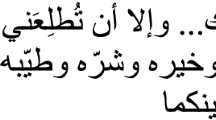Abstract
The classical Indian variety of history may be called ‘istory’. It is not completely true that no real importance was attached to istory in classical India. But much of oral istorical literature is lost since—perhaps—narrating istory was considered a performance. Unlike historical narratives, istorical narratives are presentative, not representative. Istory can be understood as a system of narrating past events that has a purpose and poetic beauty. Finally, the paper will argue that istory is based on cognitive tools of two types: epistemic tools such as testimony, inference, tarka and aesthetic tools. Thus, it has a hybrid cognitive method.
Similar content being viewed by others
Notes
See Tripathi (2014: 87) for specific mentions.
See Shamasastry: 14.
svādhyāyaṃ śrāvayet pitrye dharmaśāstrāṇi caiva hi| ākhyānānītihāsāṃśca purāṇāni khilāni ca|| Source: https://www.wisdomlib.org/hinduism/book/manusmriti-with-the-commentary-of-medhatithi/d/doc200022.html.
Tilak (2019: 59).
White (1984: 13).
Roland Barthes, The Discourse of History, translated by Stephen Bann (Source http://users.clas.ufl.edu/pcraddoc/barthes.htm).
See Stein (1900: 1–5) for a detailed account of this.
For the original text, see Siṃha (1970: 3–23).
Stein (1900: 3).
Ibid: 2.
Ibid: 4.
See Gnoli (1985: xvi) for a detailed description. I have adopted his translations of the names of aesthetic tastes.
Hughes-Warrington (2008: 30–31).
Shastri (1971: 53–54): evam-prakārāḥ pratyakṣa-paridṛśya-mānā āgamikārthāḥ karma-phala-sambandha-svabhāvā yatrāsate.
See Introduction by Iggers in Ranke (2011): xvii.
Ibid: xvi.
One may observe a poetic character in most istorical narratives. But perhaps for the first time, Ānandavardhana, Abhinava and Kalhaṇa explicitly mentioned that.
Jenkins (1995: 9).
See Guha (2012) for a detailed discussion about tarkas of different types.
Tarkabagish (1988: 375): pramāṇena khalu brāhmaṇena itihāsa-purāṇasya prāmāṇyam abhyanujñāyate. tasmād ayuktam etad-aprāmāṇyam iti... lokavṛttam itihāsa-purāṇasya viṣayaḥ.
The Vedic people never question the authority of Vedas. Everything else can be challenged.
Siṃha (1970: 3).
Śāstrī (1940: 533).
I do not wish to talk about metaphysical theories here. All these metaphysical elements are part of the background belief of the istorian.
For a complete account of this, see Gnoli (1985).
Thus ‘generation’ in this context means ‘revelation’.
Ingalls (1990: 70).
Locana of Abhinava in Śāstrī (1940: 38).
This point becomes evident when one sees the medieval paintings of falling angels.
The fundamental feeling should not be expressed through words (kāvya-balād api nānusandheyaḥ). See Gnoli (1985: 29–30) for a good discussion.
Imagine that the vision of Hell is real. In that ‘reality’, whatever causes the principal feeling (which is fear in this case) is the Determinant. The common emotive reactions of the relevant persons are the Consequents. In this case, those are the expression of trouble etc. Some reactions that appear in this piece of ‘reality’ do not regularly accompany the principal feeling. Still they enhance the feeling. Those are Transitory Mental States.
References
Gnoli, R. (1985). The aesthetic experience according to Abhinavagupta. Chowkhamba Sanskrit Series Office.
Guha, N. (2012). Tarka as cognitive validator. Journal of Indian Philosophy, 40, 47–66.
Hughes-Warrington, M. (2008). Fifty key thinkers on history. Routledge.
Ingalls, D. H. H. (Ed.). (1990). The Dhvanyaloka of Anandavardhana with the Locana of Abhinavagupta. Harvard University Press.
Jenkins, K. (1995). On ‘what is history?’ from Carr and Elton to Rorty and White. Routledge.
Perrett, R. W. (1999). History, time, and knowledge in ancient India. History and Theory, 38(3), 307–321.
Shamashastry, R. Kautilya’s Arthashastra.
Shastri, M. (Ed.). (1971). Natyashastra of Bharatamuni,. (Vol. I). Banaras Hindu University.
Siṃha, R. (Ed.). (1970). Kalhaṇakṛtā Rājataraṅgiṇī. Hindī Pracāraka Saṅsthāna.
Stein, M. A. (1900). Kalhaṇa’s Rājataraṅgiṇī: A chronicle of the kings of Kāśmīr (Vol. I). Archibald Constable and Company, Ltd.
Śāstrī, P. (Ed.). (1940). The Dhvanyāloka. Chowkhamba Sanskrit Series Office.
Tarkabagish, P. (1988). Nyāyadarśana, (Vol. IV). West Bengal State Book Board.
Tilak, S. (2019). History in India: A critique from the perspective of mīmāṃsā. In K. S. Kannan (Ed.), Swadeshi critique of videshi mīmāṃsā. Infinity Foundation India.
Tripathi, R. (2014). Aesthetics of the Mahābhārata: Traditional interpretations. In A. Chakrabarti & S. Bandyopadhyay (Eds.), Mahābhārata now: Narration, aesthetics, ethics. Routledge.
von Ranke, L. (2011). The theory and practice of history (G. G. Iggers, Ed. W. A. Iggers, trans.). Routledge.
White, H. (1984). The question of narrative in contemporary historical theory. History and Theory, 23, 1.
Acknowledgement
I am deeply indebted to Dr. Nikhil Govind (Manipal Centre for Humanities, Manipal Academy of Higher Education) and Dr. Vinita Chandra (Department of Humanistic Studies, Indian Institute of Technology (BHU), Varanasi) for their comments and suggestions on an earlier draft of this paper.
Funding
This research did not receive any grant from any funding agency.
Author information
Authors and Affiliations
Corresponding author
Ethics declarations
Conflict of interest
On behalf of all authors, the corresponding author states that there is no conflict of interest.
Additional information
Publisher's Note
Springer Nature remains neutral with regard to jurisdictional claims in published maps and institutional affiliations.
Rights and permissions
Springer Nature or its licensor (e.g. a society or other partner) holds exclusive rights to this article under a publishing agreement with the author(s) or other rightsholder(s); author self-archiving of the accepted manuscript version of this article is solely governed by the terms of such publishing agreement and applicable law.
About this article
Cite this article
Guha, N. Cognitive Tools for Narrating the Past: A Study of Classical India. J. Indian Counc. Philos. Res. 39, 237–248 (2022). https://doi.org/10.1007/s40961-023-00287-z
Received:
Revised:
Accepted:
Published:
Issue Date:
DOI: https://doi.org/10.1007/s40961-023-00287-z



